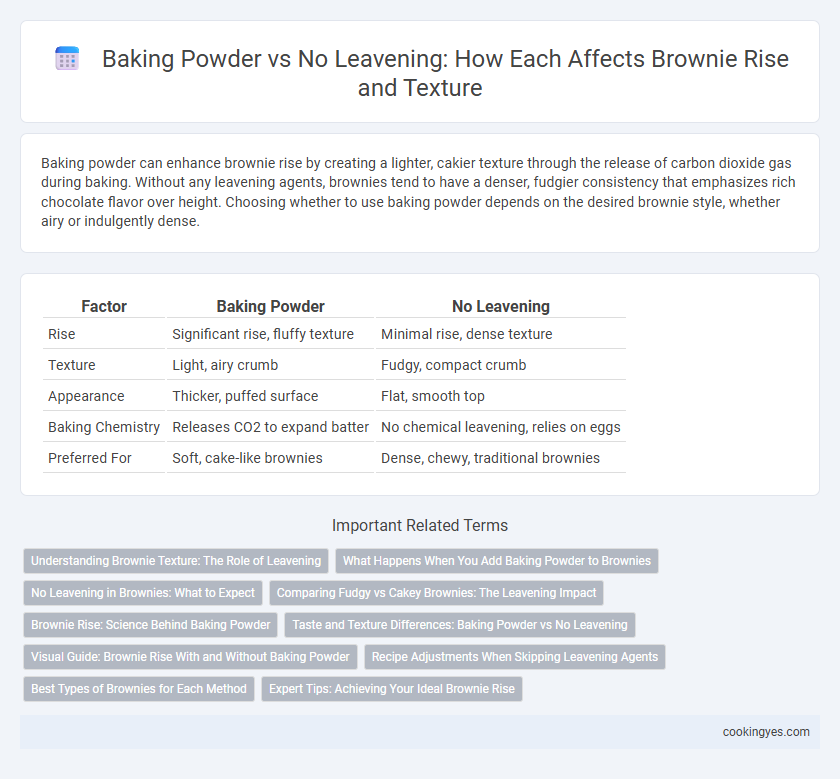Baking powder can enhance brownie rise by creating a lighter, cakier texture through the release of carbon dioxide gas during baking. Without any leavening agents, brownies tend to have a denser, fudgier consistency that emphasizes rich chocolate flavor over height. Choosing whether to use baking powder depends on the desired brownie style, whether airy or indulgently dense.
Table of Comparison
| Factor | Baking Powder | No Leavening |
|---|---|---|
| Rise | Significant rise, fluffy texture | Minimal rise, dense texture |
| Texture | Light, airy crumb | Fudgy, compact crumb |
| Appearance | Thicker, puffed surface | Flat, smooth top |
| Baking Chemistry | Releases CO2 to expand batter | No chemical leavening, relies on eggs |
| Preferred For | Soft, cake-like brownies | Dense, chewy, traditional brownies |
Understanding Brownie Texture: The Role of Leavening
Baking powder influences brownie texture by introducing carbon dioxide bubbles that create a lighter, cakey rise, contrasting with dense, fudgy brownies made without leavening agents. The chemical reaction of baking powder activates during baking, expanding air pockets and altering crumb structure to be more tender and airy. Without leavening, brownies maintain their moist, chewy characteristics, highlighting how the presence or absence of baking powder directly impacts the final texture and mouthfeel.
What Happens When You Add Baking Powder to Brownies
Adding baking powder to brownies introduces a chemical leavening agent that produces carbon dioxide gas during baking, resulting in a lighter, more cake-like texture with increased rise. Without leavening, brownies tend to be denser and fudgier due to the absence of gas bubbles expanding in the batter. The choice to add baking powder directly impacts the crumb structure, airiness, and final brownie height.
No Leavening in Brownies: What to Expect
Brownies made without leavening agents like baking powder exhibit a dense, fudgy texture that highlights rich chocolate flavor rather than a fluffy rise. The absence of leavening results in minimal air pockets, producing a moist and chewy bite that is preferred in traditional brownie recipes. Expect a compact crumb structure that emphasizes decadence over volume when omitting leavening in brownies.
Comparing Fudgy vs Cakey Brownies: The Leavening Impact
Baking powder introduces carbon dioxide bubbles that create a lighter, cakey texture in brownies, while no leavening results in a dense, fudgy consistency. Fudgy brownies rely on higher fat-to-flour ratios and less aeration, producing a moist and rich bite. The choice between cakey and fudgy brownies hinges on whether baking powder is used to promote rise or omitted to maintain that signature dense texture.
Brownie Rise: Science Behind Baking Powder
Baking powder releases carbon dioxide gas during baking, creating air pockets that cause brownies to rise and develop a lighter, fluffier texture. Without leavening agents, brownies remain dense and fudgy, as no fermentation or gas expansion occurs to lift the batter. The chemical reaction in baking powder, triggered by moisture and heat, is essential for achieving a pronounced rise in brownie structure.
Taste and Texture Differences: Baking Powder vs No Leavening
Brownies made with baking powder exhibit a lighter, cakier texture due to the leavening agent creating air pockets during baking, enhancing overall rise and crumb structure. In contrast, brownies without leavening agents result in a denser, fudgier texture with a richer, more intense chocolate flavor since there is less air incorporated. The choice between baking powder and no leavening largely impacts taste by balancing tenderness versus richness and texture by influencing moistness versus fluffiness in the final brownie.
Visual Guide: Brownie Rise With and Without Baking Powder
Brownies baked with baking powder exhibit a noticeably higher rise, resulting in a lighter, more cake-like texture with visible air pockets throughout the crumb. In contrast, brownies made without leavening remain dense and fudgy, showcasing a flatter top and a compact, moist interior. This visual difference highlights how baking powder influences the structural lift and overall appearance of brownies during baking.
Recipe Adjustments When Skipping Leavening Agents
Omitting baking powder in brownie recipes requires compensating adjustments to maintain texture and rise, such as increasing eggs to provide structure and air incorporation. Using vinegar or baking soda alone can help achieve some lift if a chemical reaction is desired, but reducing flour slightly may prevent excessive density. Adjusting mixing techniques to incorporate more air can also improve softness and rise without traditional leavening agents.
Best Types of Brownies for Each Method
Brownies made with baking powder achieve a lighter, cakey texture ideal for those who prefer a fluffy bite, making them perfect for classic or velvet-style brownies. In contrast, brownies without leavening agents produce dense, fudgy results favored in traditional or chewy recipes that emphasize richness and moisture. Choosing the best type depends on desired texture: cakey brownies benefit from baking powder, while fudgy brownies thrive without any leavening.
Expert Tips: Achieving Your Ideal Brownie Rise
Baking powder creates a lighter, airier texture in brownies by producing carbon dioxide bubbles that cause the batter to rise, while brownies without leavening yield a denser, fudgier result prized by many experts. To achieve your ideal brownie rise, use 1/4 to 1/2 teaspoon of baking powder per batch and mix gently to avoid over-aeration, preserving moistness. Expert bakers recommend adjusting leavening amounts based on pan size and oven temperature to balance lift and chewiness perfectly.
Baking Powder vs No Leavening for Brownie Rise Infographic

 cookingyes.com
cookingyes.com